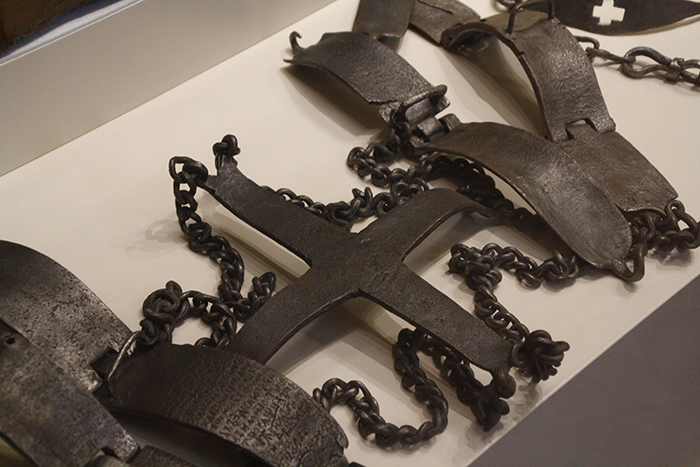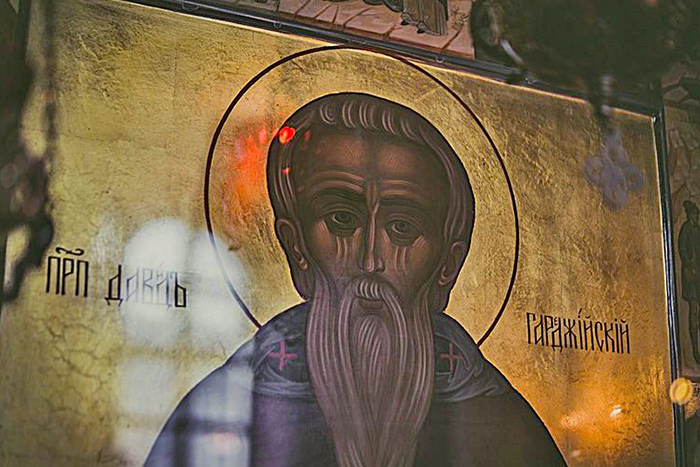
Christian ascetics and fools-for-Christ have been wearing shackles under their clothes on their naked bodies since ancient times in order to subdue their flesh and suppress their passions. The word “verigi” itself is translated from Old Slavonic as “chain”, but in fact other heavy metal objects could also be used: crosses, various plates, rings, big copper icons, iron hats and even shoe soles. Here is what St. Gregory the Theologian wrote about them, “Others exhaust themselves with iron shackles, and, as their flesh becomes weaker, their sin becomes weaker, too.” Verigi could weigh up to tens of kilograms.
Ancient ascetics based their feat of self-mortification using verigi on some verses from the New Testament, e. g., the words of the Apostle Paul: I bear in my body the marks of the Lord Jesus (Gal. 6:17), they that are Christ’s have crucified the flesh with the affections and lusts (cf. Gal. 5:24). The Apostle wrote in his Epistle to the Romans that we are baptized in Christ so that our sinful body is abolished and we are no longer slaves of sin.
Ancient Traditions in Russia
The wearing of verigi in Russia became widespread among ascetic monks already in the 11th-12th centuries. As we read the Kiev Caves Patericon, we learn that St. Theodosius († 1074), St. Mark of the Caves († ca. 1102) and St. John the Longsuffering († ca. 1160) wore iron on their bodies. For instance, Saint Theodosius, while still a teenager, “came to a blacksmith and ordered him to forge an iron belt, with which he girded himself”.
An ancient legend has it that the founder of the Polotsk Holy Savior Convent, Saint Euphrosyne, also undertook the feat of wearing verigi for many years. By the grace of God, the verigi of the saint were discovered in modern times. They are iron chains weighing seven kilograms each. They were discovered in the ancient Church of the Transfiguration of the Savior in 1991 and are now stored in the Holy Savior and St. Euphrosyne Convent.
The Feat of Saint Nicetas Stylites
The future saint lived in Pereslavl-Zalessky in the 12th century. He was a tax collector who was not ashamed of ravaging the citizens of that town. However, one day Nicetas decided to take the path of repentance and to change his life because of an extract from the book of Prophet Isaiah he heard in church.
The abbot of the monastery, whom the former publican who wished to save his soul turned to, blessed him to lock himself up in a dungeon and to wear verigi. The monk did his best to fulfill the blessing. He dug a hole and stood in it, praying and repenting of his sins. His body was now under the weight of heavy metal chains. That became the cause of the saint’s death…
The fact is, some people didn’t believe that the former tax collector would repent genuinely. Some believed that the saint’s verigi were made of precious metals, so shiny was the metal polished on the saint’s body. Some robbers decided to seize the “treasure” and murdered Saint Nicetas. Realizing that the chains were made of iron, they threw them into the Volga.
According to the Tradition of the Church, the verigi of St. Nicetas were found by a monk who lived in the Ss. Peter and Paul Monastery in Yaroslavl. He saw a miraculous glow coming from the verigi, and they themselves were floating and did not sink, as if made of wood. So they transferred the sacred object to the Pereslavl Monastery of St. Nicetas and laid it on the ascetic’s coffin.
It is definitely impossible to enumerate all the saints who used heavy verigi for ascetic purposes. Many of them wore them secretly…
Special Endeavor
Wearing verigi was a special feat requiring spiritual consideration and the blessing of an experienced spiritual leader, for, as we know, there is no virtue without discernment. As St. Philaret (Drozdov) wrote, “for … [verigi] there are people, and times, and reasons”. For example, St. Sergius of Radonezh, who by that time had already worked miracles, laid verigi on himself. However, an experienced spiritual advisor is unlikely to bless a young monk, who is at the very beginning of his ascetic journey and for whom the issue of fighting his passions is more relevant, to wear verigi. This is not a means of achieving holiness but a tool for suppressing passions, which is currently used very rarely.
For the Benefit of the Soul
The word “verigi” also has a figurative meaning. It’s a burden, usually a moral or a mental one. Verigi can be seen as part of a high and complex culture of self-restraint. Many people who are far from the inclination toward moral advancement say, “Why do we need to practice prayer, fast, endure grudges and tame passions – in short, do everything that is contrary to the biological nature of a living being? Why is this self-abuse? Why torture yourself by the weight of verigi? Is it not better to march through life joyfully and easily?”
Let us remember King Solomon’s words from Song of Songs, Love is as strong as death. Love is not meant as a feeling, as most people think. Love is a force, and the essence of any force is its desire to express itself in action, and in this case it means reorienting itself from caring for the body to caring for the soul, for the eternal soul, for the eternal human being. Fasting, vigilance, seclusion in a pillar are also a kind of verigi. It is a virtue to believe that the soul is more important than the body. A person who dares to do it has placed faith in the foundation of his life. It is not difficult to wear spiritual “verigi” if you know that it is the saints’ kettlebells, while for us it is an exercise in love.
Translated by The Catalogue of Good Deeds
Source: https://obitel-minsk.ru/chitat/den-za-dnyom/2020/verigi



